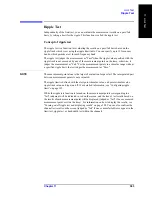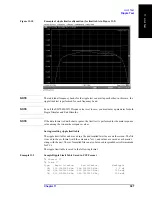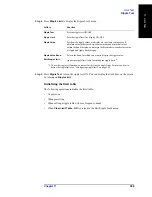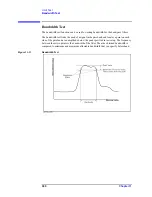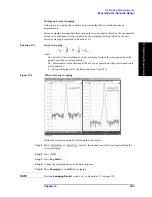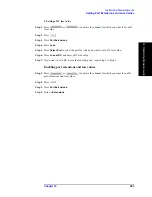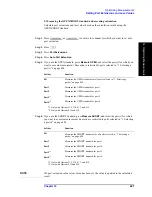
Chapter 12
395
Optimizing Measurements
Expanding the Dynamic Range
1
2
. O
pt
imiz
ing
M
e
as
ur
em
e
nt
s
Turning on Sweep Averaging
Using sweep averaging also enables you to reduce the effects of random noise on
measurements.
Sweep averaging averages data from each point (vector quantity) based on the exponential
average of a continuous sweep weighted by the averaging factor specified by the user.
Sweep averaging is expressed in Equation 12-1.
Equation 12-1
Sweep Averaging
A
n
S
n
F
-----
1 1
F
---
–
⎝
⎠
⎛
⎞
A
n
1
–
×
+
=
where:
An = Result of the calculation of sweep averaging for the nth sweep operation at the
point in question (a vector quantity)
Sn = Measurement value obtained at the nth sweep operation at the point in question (a
vector quantity)
F = Sweep averaging factor (an integer between 1 and 999)
Figure 12-2
Effects of sweep averaging
Define the sweep averaging by following the steps below.
Step 1.
Press
or
to select the channel on which you want to define the
sweep averaging.
Step 2.
Press
.
Step 3.
Press
Avg Factor
.
Step 4.
Change the averaging factor in the data entry area.
Step 5.
Press
Averaging
to turn
ON
the averaging.
NOTE
Pressing
Averaging Restart
resets n to 1 in Equation 12-1 on page 395.
Summary of Contents for E5070B
Page 6: ......
Page 30: ...24 Contents ...
Page 34: ...28 Chapter1 Precautions Before contacting us ...
Page 286: ...280 Chapter6 Data Analysis Using the Equation Editor ...
Page 430: ...424 Chapter12 Optimizing Measurements Performing a Segment by Segment Sweep segment sweep ...
Page 538: ...532 Chapter15 Measurement Examples Executing Power Calibration ...
Page 634: ...628 AppendixB Troubleshooting Warning Message ...
Page 732: ...726 AppendixD Softkey Functions Trigger Menu ...
Page 740: ...734 AppendixE General Principles of Operation Data Processing ...
Page 760: ...754 AppendixF Replacing the 8753ES with the E5070B E5071B Comparing Functions ...



